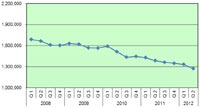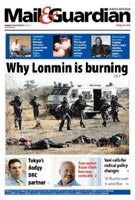
In the news
M&G, Argus and Cape Times ABC backstories reveal future trends
But the backstory is very useful in that it offers insight into future circulation trends and whether a decline or rise in the numbers may be temporary or not.

Once again, the latest Audit Bureau of Circulations (ABC) figures - for the second quarter of 2012 - that came out last week, paint a picture of general sustained circulation decline in the country's newspapers. There were, however, three titles in which I was particularly interested: the Mail & Guardian and Independent Newspapers' Cape Argus and Cape Times.
The M&G is interesting because after about a year of sustained growth, the paper suffered a decline in the first and second quarters of this year.
The paper is down to 46 518 total circulation in the second quarter (Q2) of 2012 compared with 48 016 in the same period last year - 34 293 single-copy sales this year compared with 37 407 last year.
The Cape Argus and Cape Times are very interesting because in March this year, the Argus changed from a broadsheet to tabloid format - the company is calling it a 'compact' - and started moving from the afternoon into the morning market, raising concerns that even though they serve different markets the Argus might cannibalise the Cape Times' sales.
The ABC figures for the second quarter of 2012 show:
- The Argus fell from 45 924 total circulation a year ago to 35 332 this year while single-copy sales experienced a lesser drop: from 20 861 a year ago to 19 744 this year.
- The Cape Times fell from 43 950 total circulation a year ago to 37 948 this year (after holding steady and even showing increases in the 2011) while single-copy sales fell from 23 793 a year ago to 19 851 this year.
So what gives here? Best to seek out the backstory, I thought.
In the case of the M&G, editor Nic Dawes says this year's falls can be partly attributed to their distribution agents tightening up returns and partly to some M&G readers opting to read the paper on Kindle (which is not yet counted by the ABC) and iPad (which is).
"Flat and still ahead of 2012"
"It looks like we're basically flat and still ahead of 2010 so I'll take it, frankly," says Dawes, adding that iPad and Kindle sales together now account for about 25% of the M&G's subscriptions.
Kindle sales are now at about 1 600 a week and iPad is at about 700 while the paper will be launching on Android soon. "There's a real migration there to paid-for digital products," Dawes says.
According to ABC figures, the M&G's digital sales for the second quarter of 2012 came in at 496 weekly.
Digital sales can only counted by the ABC if it carries all the ads that appear in the print edition and Dawes says that his team weren't always able to do that through the second quarter as they were still learning about producing for iPad.
At Independent Newspapers, the acting Western Cape GM, Sandy Naudé, told Bizcommunity that some of the Argus and Cape Times declines can be attributed to a drop in business subscriptions as companies are preferring to order fewer papers in our straightened economic times.
However, the biggest factor is that the Argus and Cape Times started doing away with incentivised sales during the second quarter of this year.
Focusing on core circulation
Incentivised sales are those that are discounted or given away for free such as in third-party bulking deals or what is termed Print Media in Education (PMIE), which are papers given to school to aid literacy and education.
They are counted - but itemised - in the 'total circulation' numbers by the ABC. They can help to prop up circulation but there are still costs involved in printing and distributing the papers.
A couple of years back, Media24 was the first of the big four print-media houses to drop this (sometimes) dubious practice and to start focusing on core circulation - a move very much in tune with the growing feeling among media planners and buyers that although CSI-like efforts such as PMIE are admirable, they have no place in audited circulation figures.
"It's not just the cost; it's actually the value to clients," says Naudé. "We would rather focus on the core sales to ensure that the best value is going out to the reader... Of course, we're working on digital strategies and I think in the next ABCs that'll start to come through and we'll build from there."
According to the latest ABC figures, the Cape Times reported 83 digital sales in Q2 2012 while the Argus did 47.
Another factor to consider in the Argus circulation numbers is that its morning distribution network is still in the process of being set up. Although the paper is getting out there in Cape Town and beyond in the country areas on the Cape Times trucks, the two papers service different markets so this is far from ideal.
Migration is positive
The question then is what can we glean from these backstories in terms of where these papers are going in the future?
The M&G looks like it is holding steady and being a high-end title, migration to iPad and Kindle (and Android) can only be positive for its future.
The Argus' future looks mostly favourable, considering that its single-copy sales didn't take a bigger knock with the dramatic change in format and the fact that the morning distribution network is still being put in place. Nevertheless, reader habits have undoubtedly been disrupted - some people have stopped reading the paper - and I'd say the Argus needs a big marketing drive to accompany the sorting out of its distribution routes.
The Cape Times' future is concerning. The significant drop in both total and single-copy sales suggests that the Argus has won over some of its readers so I think the paper needs to inject vooma into its content accompanied with a marketing drive to arrest the recent fall... And the roll out those apps already!
It's still early days so, with savvy editing and aggressive publishing, stemming the decline should be achievable. However, if they don't act fast, the situation will only worsen.
Single-copy sales figures are, of course, viewed as the real deal when it comes to gauging the health of a title as trends up or down will happen here first - before subscriptions.
While most papers suffered yet another circulation decline in the second quarter of this year (in fact, circulation across ABC-audited daily newspapers has been falling annually by 5.5 % since 2008 and weekend papers by 2.6%), there were some that bucked the trend. Those that rose in single-copy sales include:
- The Sunday Times (owned by Avusa), now at 253 121 compared with 249 168 in the second quarter of 2011.
- Publishing phenomenon Isolezwe (owned by Independent Newspapers) is now at 112 648 single-copy sales compared with 107 143 in 2011. Isolezwe ngeSonto (the Sunday edition) is at 89 534 compared with 80 120 in the second quarter of 2011. It's also worth noting that the Saturday edition, Isolezwe ngoMgqibelo, has now reached a remarkable 75 934 single-copy sales after launching in August 2011.
- The Sowetan (owned by Avusa) is at 89 282 single-copy sales, up from 88 749 in 2011 while sister paper, The Herald, in Port Elizabeth is pretty much holding steady. It was at 15 096 single-copy sales in Q2 2012 compared with 15 516 in 2011.
- Media24's Bloemfontein-based daily, Volksblad, is also holding steady at 12 103 single-copy sales compared with 12 755 in Q2 2011.
All of the above have good reason to be chipper and there'll be interesting backstories in all of them. Come back to Bizcommunity next week for these and an analysis of rising media inflation.
For more:
- Bizcommunity: isiZulu papers, City Press are the ABC circ winners, May 2012
- Bizcommunity: Set for more growth after 10 years, says Isolezwe editor Mazwi Xaba, May 2012
- Bizcommunity: Chris Whitfield on balancing act of Cape Argus move, March 2012
- Bizcommunity: Newspapers dire but not dead, say latest ABC circ numbers, February 2012
- Bizcommunity: Magazine ABC circ holds promise but consumer loyalty declining, February 2012
- ABC: Second quarter 2012 presentation by Gordon Patterson
- Politicsweb: How SA newspaper can save themselves, October 2011

About Gill Moodie: @grubstreetSA
Gill Moodie (@grubstreetSA) is a freelance journalist, media commentator and the publisher of Grubstreet (www.grubstreet.co.za). She worked in the print industry in South Africa for titles such as the Sunday Times and Business Day, and in the UK for Guinness Publishing, before striking out on her own. Email Gill at az.oc.teertsburg@llig and follow her on Twitter at @grubstreetSA.Related
ABC Q3 2024: A quiet quarter for newspapers 21 Nov 2024 ABC Q2 2024 Newspapers: Dailies and local newspapers buck the general continuing decline 22 Aug 2024 Report shows the decline of print newspapers over the past decade 11 Jul 2024 Newspapers: ABC Q1 2024: The slow steady downward trickle continues 23 May 2024

















